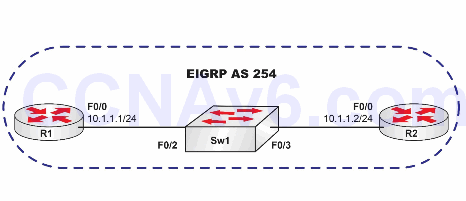Lab Objective:
The objective of this lab exercise is for you to learn and understand how to enable basic EIGRP routing using a single autonomous system.
Lab Purpose:
Enabling basic EIGRP routing is a fundamental skill. EIGRP is an advanced distance vector routing protocol. It is also a Cisco proprietary protocol (but now also an open standard) that runs over IP protocol number 88. As a Cisco engineer, as well as in the Cisco CCNA exam, you will be expected to know how to enable basic EIGRP routing.
Certification Level:
This lab is suitable for ICND2 and CCNA certification exam preparation.
Lab Difficulty:
This lab has a difficulty rating of 4/10.
Readiness Assessment:
When you are ready for your certification exam, you should complete this lab in no more than 10 minutes.
Lab Topology:
Please use the following topology to complete this lab exercise:

Task 1:
Configure hostnames on R1, R2, and Sw1 as illustrated in the topology.
Task 2:
Configure VLAN10 named EIGRP_VLAN on Sw1. Keep in mind that, by default, Sw1 will be a VTP server so you can simply create the VLAN and assign it the name provided. Next, assign ports FastEthernet0/2 and FastEthernet0/3 on Sw1 to VLAN10 as access ports and enable those ports.
Task 3:
Configure the F0/0 interfaces on R1 and R2 with the IP addresses in the topology and bring up the interfaces. Perform a ping from R1 to R2, and vice versa, and ensure that the routers can ping each other.
Task 4:
Enable EIGRP on R1 and R2 for the subnet configured on their F0/0 interfaces. Make sure that EIGRP uses ASN 254 as illustrated in the topology.
Task 5:
Verify that an EIGRP adjacency has formed between R1 and R2 using appropriate commands.
Configuration and Verification
Task 1:
For reference information on configuring hostnames, please refer to earlier labs.
Task 2:
For reference information on configuring and verifying VLANs, please refer to earlier labs.
Task 3:
For reference information on configuring and verifying IP addressing, please refer to earlier labs.
Task 4:
R1#conf t Enter configuration commands, one per line. End with CTRL/Z. R1(config)#router eigrp 254 R1(config-router)#network 10.0.0.0 R1(config-router)#end R1# R2#conf t Enter configuration commands, one per line. End with CTRL/Z. R2(config)#router eigrp 254 R2(config-router)#network 10.0.0.0 R2(config-router)#end R2# *Mar 1 00:11:46.782: %DUAL-5-NBRCHANGE: IP-EIGRP(0) 254: Neighbor 10.1.1.1 (FastEthernet0/0) is up: new adjacency R2#
NOTE: When configuring EIGRP, you must use an ASN. This can be any number from 1 through 65535. This is configured as follows:
R1(config)#router eigrp ? <1-65535> Autonomous system number
In addition, when you configure EIGRP, you will see an adjacency form if EIGRP has been configured correctly. This will be indicated by the log message printed on the console:
*Mar 1 00:11:46.782: %DUAL-5-NBRCHANGE: IP-EIGRP(0) 254: Neighbor 10.1.1.1 (FastEthernet0/0) is up: new adjacency
Task 5:
R1#show ip eigrp neighbors
IP-EIGRP neighbors for process 254
H Address Interface Hold Uptime SRTT RTO Q Seq
(sec) (ms) Cnt Num
0 10.1.1.2 Fa0/0 13 00:07:40 1 4500 0 1
R1#
R2#show ip eigrp neighbors
IP-EIGRP neighbors for process 254
H Address Interface Hold Uptime SRTT RTO Q Seq
(sec) (ms) Cnt Num
0 10.1.1.1 Fa0/0 13 00:04:56 862 5000 0 1
R2#
